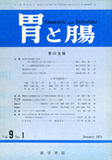Japanese
English
- 有料閲覧
- Abstract 文献概要
- 1ページ目 Look Inside
- サイト内被引用 Cited by
最近,わが国の各施設における胃生検の早期胃癌診断率は90~95%をこすが1),診断に際して未だ種々の疑問を抱かせる症例にしばしば遭遇する.この検査が胃切除を要するか否かの最終的判定をくだす重要な臨床的役割を果すことから,臨床医および病理学者もその結果について絶えず反省し,より良き診断成績の向上に努めるべきであることは言をまたない.
本文においては,横山胃腸科病院において過去約5年間に行なわれた胃生検1,812例を資料として,主題の陥凹性病変を特に胃癌診断にしぼり検討を加えたい.
In excavated gastric lesions, biopsy diagnoses often meet with difficulties in distinguishing atypical regenerative epithelium from malignant one. This paper deals with this problem on ground of our experiences in the false-negatives and false-positives of biopsy diagnoses.
During the 5-year period from March, 1968 throgh June, 1973, 35, 265 cases of gastric endoscopy were performed, of which 1,120 cases with excavated lesions, e.g., ulcers, erosions, and Ⅱc like lesions, etc., received biopsy studies. In most cases “Machida FGS-BL” was used, and specimens taken were treated with our 2-hour paraffin block method. The H-E staining was usually applied, in some, when needed, other staining methods, e.g., PAS staining, were done in addition.
355 pases proved to be gastric cancer. Of 1,120 biopsy cases, 466 received gastric resection. Based on histological findings of the resected stomachs, it was found 4 cases (1.4%) were the false-negatives and 9 cases (5.3%) were the false-positives.
In 2 of the false-negatives sites of biopsy were inappropriate, namely outside of Ⅱc lesions. In the remaining 2 cases (Ⅱc+Ⅲ and Ⅲ+Ⅱb) biopsies were taken from the crater edge, but regenerative characteristics of their histology were more prominent than those of lesions apart from the crater, so that biopsy diagnoses could not deduce the malignancies. This suggests that biopsies of these lesions apart from a crater might represent truer nature of the tumor than those around the edge.
In 8 out of 9 false-positive cases immature regenerative epithelial cells were misdiagnosed as differentiated adenocarcinoma. These cells are very likely to be taken off en bloc and also to be deformed by biopsy forceps, because of scanty attachment to connective tissue. This often brings about transformation of tissue, simulating adenocarcinoma. It is suggested that biopsy diagnosis of a crater edge must be made on those specimens where tissue structure is well preserved.
In one of the false-positives a group of hypertrophied capillary endothels in the granulation tissue of an ulcer were misdiagnosed as non-differentiated adenocarcinoma. Additional mucus staining is only a definitive clue to exclude non-epithelial nature of these tissues.
A few cases were also presented in addition to show diagnostic difficulties in biopsies of those where non-differentiated adenocarcinoma develops in a close connection with regenerative epithelium, and of those with reactive lymphoreticular hyperplasia in which degenerative epithelium among the lymphoreticular infiltration mimics non-differentiated adenocarcinoma.

Copyright © 1974, Igaku-Shoin Ltd. All rights reserved.


